“Bringing home our Gods”
Nationalistic and Populistic Dangers in Debates about Heritage Restitution in India
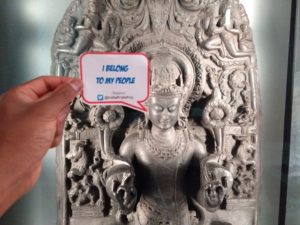
“I belong to my People” Support @IndiaPrideProj
Recent years have witnessed overall debates about the legitimacy and the future of the museum, especially of the ethnographic museum. An important reason for this is the question of provenance.
How did the objects we encounter when visiting a museum get there and what does that mean? These are in short the central questions of provenance research. For the last few years provenance and especially restitution claims have become highly controversial and pressing topics. All the more so since the so-called restitution-report commissioned by French president Macron on former French colonies in Sub-Saharan Africa has been published and discussed not only by an expert audience, but by the wider public. The fact that France seems to prepare the return of African artefacts looted in its colonial era marks a turning point in the discussion. Indeed, Germany is influenced by these discussions, too. With the national prestige project of the Humboldt Forum in Berlin, a new museum complex dedicated in large parts to non-Western art and material culture, Germany is redefining its self- and public image as a liberal and cosmopolitan nation by showcasing the cultures of the world in the historic city centre. The political and legitimising function of art since time immemorial is reflected in such ambitious national projects until today.
Unfortunately, Asia and especially South Asia is underrepresented not only in such discussions, but in the ethnographic world in Germany in general. There are complex reasons for that, which cannot be elaborated here. However, this is all the more disturbing as Indology or Indian Studies – and this is where most scholars, irrespective if art historians, ethnographers, historians or other disciplines specialising in South Asia usually come from – have a long and impressive history in Germany since the Romantics with August Wilhelm Schlegel as the first professor of Indology at Bonn University in 1818. [1] On the other hand in recent years, most Indology chairs of German universities – contrary to Chinese Studies – could obviously not argue in favour of their field and exemplify its importance. [2] At conferences or in the press for example one rarely hears about case studies from South Asia, the state of the art of the museum world or discussions about cultural heritage politics on the subcontinent.
It is this overall context the author would like to enrich with a few observations from the Indian context and analyse current debates about heritage restitution in India. The aim is to critically analyse problematic argumentations in discussions of restitution demands and the misuse of the very often legitimate demands in a political climate of Hindu nationalism.
For this discussion, and heritage restitution in general, an important distinction must be made: Between the illicit trafficking of cultural goods after Indian independence in 1947 and the acquisition methods during the colonial period, which often consisted in looting. Regarding the legal status, the former is a crime and should clearly be fought against, while colonial looting was in general legal. Of course, these laws were created by the colonisers. It is well known that even legitimately acquired objects might have illicit pasts. Therefore, when discussing colonial looting one can in most cases not argue on a legal basis but must retrospectively look at its history and apply ethical criteria, which societies and politics are currently negotiating. This is also the case in India, a country still battling with its postcolonial legacies in many ways.
Looting in Colonial India
Before discussing current restitution claims, I would like to introduce briefly the history and politics of looting in colonial India. Historically and globally, looting has been a vital part of warfare from time immemorial. The distribution of the plunder served to motivate the troops, who hoped to gain their due share, filled the state coffers and humiliated the enemy. Not only material culture but also slaves, riding animals, food or items of everyday life were taken away forcefully from the local population without reimbursement. Armed conflicts in British India were no exception, and several such incidents are documented. The most important ones probably were the systematic lootings in the context of the so-called Indian mutiny in 1857 centred around Lucknow in Uttar Pradesh. [3] Even officially appointed prize agents handled the collection and distribution of spoils.
Regarding jurisdiction in India, the Treasure Trove Act of 1878 belongs to the earliest legislation. Set up by the British colonial government it handled the protection of archaeological and other material of historical importance but did not outlaw the removal of such material out of the country. Therefore, bringing artefacts to Western collections was considered legal. [4] This must have been the case in most instances, for example when the ancient Buddhist site of Amaravati was discovered. Numerous cases like this one prove the improper excavation by self-proclaimed hobby archaeologists. For example, Amaravati in the state of Andhra Pradesh, which is among the most important cultural monuments of ancient India and flourished from about the 3rd century B.C. to the end of the 14th century A.D., was finally ‘rediscovered’ in 1797 by Colonel Colin Mackenzie. Since 1816 various unprofessional and unsystematic excavations brought the partly looted, devastated and collapsed Stupa (Buddhist burial mound) into the focus of art historical interest. In 1880 the site was completely cleared by order of the then Governor of Madras, and all of the 380 finds were transported to Madras and London, so that today only an artificial hill, surrounded by a few foundations, can be seen at the actual site. [5]
In the case of periods of war, the Hague Convention of 1899 (Convention (II) with respect to the Laws and Customs of War on Land), as the precedent of the Geneva Convention, already stated that “private property cannot be confiscated” and “pillage is formally prohibited”. [6] That such standards were not met by the British can be seen for example in the well documented case of the British Younghusband Invasion of Tibet in 1903/04 and the heavy occurrence of looting. [7]
However, in the second half of the 19th century collecting for the welfare of the Empire’s institutions and for private passion became increasingly important due to the general interest in knowledge enhancement and imperial archive building. The goal was to record and measure local monuments and sites, customs, tribes etc. It was in this context that many ‘oriental’ academic disciplines, such as Indology, Buddhist Studies or South Asian Art History, developed, which still shape the knowledge of South Asia in problematic ways until today. The British set up a system of classification of Indian heritage and defined what was valuable and should be preserved in both Indian museums and back home. In its wake the oldest museum of India, the Indian Museum in Kolkata was founded in 1814 and modelled after the British Museum in London along the category of National or Imperial Museum. It has remained an encyclopedic museum until today.
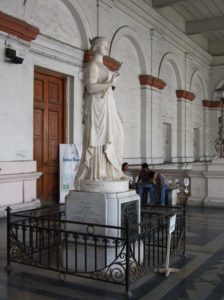
Marble statue of Queen Victoria, ‘Empress of India’, from 1877 in the Indian Museum, Kolkata. Photo R. Höfer 2012
Regarding the looting of artefacts, the moral attitude changed at the end of the 19th century and looting became morally questionable and regarded as something barbaric and unworthy of the British. This change was related to certain developments in late Victorian imperialism. From the beginning, British imperialism was intellectually rooted in the assumption of moral and religious superiority, and the natural obligation to colonise and rule. Colonial officers served in the imperial structure as the embodiment of these virtues and were thought of as ‘gentlemen officers’. The British moral superiority however underwent a crisis – both in the psychology of the British and their international appreciation. This was due to events still active in the public memory such as the looting and burning of the Summer Palace in Beijing by British troops in 1860 and the South African War, [8] which cost the Empire much sympathy and contributed to the questioning of its legitimacy. Consequently, looting, especially of religious buildings, was increasingly criticised in the nationalist and liberal press in India, much less so in Britain. Accordingly, in 1899 after his arrival in India the Governor General and Viceroy of India, Lord Curzon, strived to consolidate moral principles, push forward certain reforms and ban looting. [9]
Although looting, from the end of the 19th century onwards, did not match the official British policy, and incidents of looting were reported early on and even critically discussed by the public, the government, while condemning it in theory, did not take sufficient practical measures to prevent it. However, this describes only the situation from the end of the 19th century onwards. This means that before this change and thus for the longest time of British rule in India, looting was regarded as adequate. That objects were in many cases looted or purchased under dubious conditions from today’s perspective could be taken for granted, but – and this is an important point – even from the viewpoint of many contemporaries, war looting, especially from religious sites, has been evaluated critically. Regarding the reimbursement of objects, even these instances pose difficult questions: it is likely that in many cases locals were cheated of an adequate price or were refunded with cheap presents only. Another but more general problem centres around the question of the removal of active cult objects – irrespective of whether forcefully taken or not – from sacred contexts for use in a profane environment. The author is not expanding on the complex and manifold ways of object acquisitions in India, but rather hopes that it becomes clear how complicated and ambivalent the situation was and still is.
Contemporary Illicit Trafficking of Cultural Goods in India
Although several new laws on heritage protection were created after Indian independence in 1947 these rely on earlier colonial ones. Most dealt with the prevention of the smuggling of artefacts and did not focus on recovery, like the Antiquities Export Control Act (18.4.1947). In 1972 when it became more and more obvious that huge quantities of Indian cultural heritage were traded on the art market for increasing prices it was replaced by India’s Antiquities and Art Treasures Act which requires any privately owned work of art that is more than a hundred years old to be registered with the government. [10] Though it is generally illegal to export such objects, local and international antique dealers still find criminal ways to cater for an international art clientele. To combat this art mafia remains a huge task worldwide.
Regarding Indian artefacts, recently the case of the so far well reputed New York-based antique dealer Subhash Kapoor who sold for nearly four decades pieces to every major museum of the world, became prominent after his arrest in 2011. [11] Indeed, the Linden-Museum in Stuttgart (State Museum of Ethnography) bought from Kapoor in New York a relief stele for c. 224,000 Euro in 2000, which after his arrest turned out to have been stolen from a temple in Tengpona in 1991. The incarnation of the Hindu goddess Durga from the 9th or 10th century was returned on 5.10.2015 by German Chancellor Angela Merkel to the Indian Prime Minister Narendra Modi in New Delhi. Regarding the uncompensated return to India for ‘ethical reasons’, the Secretary of State in the Ministry of Science, Research and Arts, Jürgen Walter stated: “The importance of a good reputation [of the state] exceeds by far the material value of the statue.” [12] Art and cultural heritage are obviously considered as a political and diplomatic soft power.
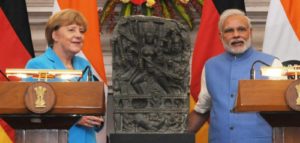
German Chancellor Merkel and Indian Prime Minister Modi upon the festive return of a relief stele from Linden-Museum in Stuttgart in 2015. dpa/rg pt
In India, a caricature depicting Vaman Narayan Ghiya, the “King of Idol Thieves”, illustrates the immense problem with illicit trafficking of cultural goods emblematically. The antique dealer from Jaipur was arrested in 2003 and found guilty of the largest antiquities smuggling in Indian history. [13]

The contemporary “King of Idol Thieves”, Vaman Narayan Ghiya. Caricature by Gerald Scarfe, The New Yorker, 30.4.2007.
The India Pride Project
In contemporary India people are battling with their colonial past in many ways. As can be seen for example in the colonial erection of the statue of Queen Victoria from Fig. 2, which is still in place in the Indian Museum in Kolkata without providing a historical or critical explanation to its visitors, many state institutions don’t apply a postcolonial approach in dealing with their past and even seem to deny the necessity. Especially among common people there is not much awareness of such topics and even old colonial place names are often still in use instead of the renamed ones. Therefore, it is clearly an elitist upper class phenomenon to be aware of and interested in the historical and contemporary translocations of artefacts or the discussion about restitution. English speaking newspapers may from time to time raise such topics and report on related incidents such as the return of the Durga statue from Stuttgart. However, at the moment, the press coverage on such topics is much higher and much fiercer in Germany than in India.
So far, the main contemporary protagonist regarding restitution discussions in India and in global Indian communities is the India Pride Project (IPP). It devotes its work, under the motto “Bringing home our Gods” to repatriation. [14]

Homepage header of the India Pride Project. http://ipp.org.in
The lead story on the homepage reads: “For thousands of years, our gods have been looted. Nobody has bothered to bring them back. UNTIL NOW.” According to its homepage it is “a volunteer-network spread across the globe, that tracks and brings back India’s stolen heritage. We also build awareness about the issue, so citizens and officials understand why this is crucial to India from a geo-political perspective.” [15] The Singapur-based activist, author and commentator of Indian descent, Anuraag Saxena, founded the network in 2013. Since then he has been in the forefront of the discussions about Indian heritage repatriation. According to Saxena his group cooperates with the government, international agencies, museums and a small global curator community to investigate cases of missing antiquities and demand their return. So far, they have resolved five cases. Their press covering in Western media is enormous and their greatest impact might lie in the raising of awareness on the topic and the networking of global supporters.
The extent of cooperation with India’s ruling BJP (Bharatiya Janata Party: “Party of the Indian People”) and Saxena’s personal political attitude can only be guessed. He himself is clearly avoiding the issue. According to the author’s opinion, his social media accounts point towards a Hindu-nationalist attitude. It is a fact that under Prime Minister Modi and his ruling BJP India got back more stolen antiquities in three years than the United Progressive Alliance (UPA) government in ten years. According to a government official “bringing back Indian artefacts and cultural heritage remains a “key element in India’s foreign policy”. […] The return of these historical objects is part of the “restoration of India’s pride and an acknowledgement of history” as well as a projection of India’s soft-power.” [16] The Washington Post describes Saxena’s IPP as an example of India’s emerging geo-political influence and says that “countries such as China and India are taking new pride in their history and national heritage is only natural, given their growing economic and political clout”. [17]
That the IPP researches cases of contemporary illicit trafficking of Indian artefacts is highly meritorious. However, its claims about object acquisitions from colonial times are questionable. In the following the author investigates some of those claims and how they are rhetorically and visually achieved.
The introductory text of the IPP homepage reads as follows: “The Mughals plundered us. Then the colonials. It’s time to get our Gods back home. India’s cultural treasures have been looted for centuries. First by the Mughals, then by the colonials. But now, it’s by our own people. Large and sophisticated criminal-networks spanning across the globe have systematically looted our history. They have looted India’s pride. Ancient Indian sculptures, manuscripts, maps and artifacts are stolen and find their way into the international art-markets and are sold off for millions of dollars. Our history is being illegally smuggled out to private-collectors and museums across the world. The “India Pride Project” is a small, but brave attempt to bring this loot back. Back into our country. Back to their homes. To where they belong!” [18]
In the introduction the IPP blames right from the beginning the Mughals and the colonisers for being plunderers. In another passage looting is equated with the loss of India’s pride and thus heavily emotionalised. Then the IPP is associated with regaining this pride by claiming back what belongs to India. These are only a few examples from the IPP homepage and its social media channels illustrating their communication strategy. In a populist and inflammatory manner the IPP falls back on certain heavily emotionalised stereotypes like the Mughal reign, comparisons with Pakistan, the evil West and the British rule. Referring to the Muslim dynasty of the Mughals who conquered India in 1526 and reigned as foreign rulers until 1761 is a common stereotype used in Indian history again and again in order to fuel conflicts between the majority of the Hindu Indians and the minority of Muslim Indians. The state motto “Unity in diversity” which evokes the unity of India’s many minorities is under actual threat due to the Hindu-nationalist and fundamentalist politics of the BJP. This focus on “everything Hindu”, called ‘Hindutva’, originally meant ‘Indian’ in a geographical sense and implicated a common culture, but was later on related to religion and became exclusive. [19] Since the partition of the subcontinent into both India and Pakistan prejudices against both population groups from both sides have flared up regularly. However, in recent years it has been the BJP which regularly furthers such long-term animosities in India. That such controversies arise around symbolically loaded historical monuments and sites proves the power of art until today. One well-known example is the violent dispute around Ayodhya, an ancient town in Uttar Pradesh, which is regarded by Hindus as one of the seven holy cities and associated with the god Rama. The Babri mosque was built in the 16th century by the Mughal emperor on a site traditionally identified as Rama’s birthplace. Since the first riots in 1990 until today over 2000 people have died in conflicts around the site. In 1992 a crowd of Hindu nationalists closely associated with the BJP could not endure this “Muslim humiliation” any longer and demolished the mosque in order to erect a temple for Rama. [20]
“Agony Shrieks”
In 2018 volunteers from IPP based in London initiated a novel social media campaign. While visiting the British Museum they captured “Agony Shrieks” – a term used by the activists – from statues on display and posted these.
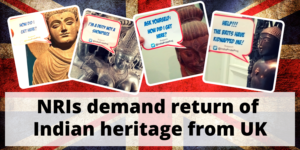
“Agony Shrieks” social media campaign by the India Pride Project in the China and South Asia Gallery at the British Museum in 2018. https://medium.com/@IndiaPrideProj/nris-demand-return-of-indian-heritage-from-uk-629998dec1e1

“Agony Shrieks”- social media campaign at the British Museum: “How did I get here?” and “Help!!! The Brits have kidnapped me!”. https://medium.com/@IndiaPrideProj/nris-demand-return-of-indian-heritage-from-uk-629998dec1e1
From the absolutely legitimate initial question “How did I get here?” in the picture with the Gandhara Buddha on display, which is suitable to raise visitor awareness, the narrative quickly proceeds to dramatic statements like “Help!!! The Brits have kidnapped me!”.

“Agony Shrieks”- social media campaign at the British Museum: “I’ve been snatched, sold, paraded, shamed” and “My people wait for me”. https://medium.com/@IndiaPrideProj/nris-demand-return-of-indian-heritage-from-uk-629998dec1e1
The slogan in this picture “I’ve been snatched, sold, paraded, shamed”, is in the author’s opinion highly problematic and populistic. Connotations evoked especially by the terms ‘paraded’ and ‘shamed’ in this context remind one of historic slave trade or human trafficking and is simply inappropriate for an inanimate object like a sculpture. Terms like these insult true victims from all over the world, including for example the masses of Indians shipped abroad as indentured servants in the course of British rule.
Slogans like “My people wait for me” or “I belong to my people” in the case of a statue of a spiritual leader from the Jain religion address again highly problematic issues of identity and representation. That the campaign does not exclusively focus on Hindu artefacts but includes Buddhist and Jain artworks seems a mere superficial concession to India’s “Unity in Diversity” given the fact that the BJP’s policy consists in ‘Hindu India first’. From a Hindu point of view the recourse on Buddhism or Jainism embraces India’s glorious past and can be seen in the broadest sense as part of an appropriation into Hindu culture. On the other hand, the IPP never refers to Islamic or Sikh artefacts and thus follows the line of BJP activism highlighting the controversies against Hindus and Muslims and drawing back to old narratives such as the Muslim invader as looter or old rivalries with the Sikh community.
As a follow up of the “Agony Shrieks” campaign in the British Museum, the IPP set up an “MP outreach program”: It asked British citizens of South Asian origin to reach out to influential MPs to make the moral case for heritage-restitution. IPP founder Saxena writes: “There are 48 British MPs that represent constituencies with significant Persons-of-Indian-origin. We are confident these parliamentarians would not offend an ethnic minority’s sentiments who want to see their heritage go back home.” [21] It is indeed striking that mostly non-resident Indians or even those of other nationalities, but with Indian descent, support the IPP and it is obvious how their diasporic feelings of patriotism and cultural belonging are mobilised.
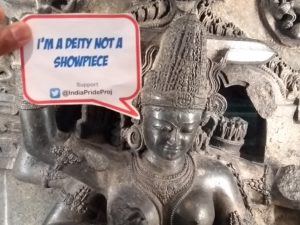
“Agony Shrieks”- social media campaign at the British Museum: “I’m a deity not a showpiece” and “I’m being objectified”. https://medium.com/@IndiaPrideProj/nris-demand-return-of-indian-heritage-from-uk-629998dec1e1
In particular the slogan “I’m being objectified” seems once again inappropriate and reminds one of other dimensions of human life like the sexualisation of women. These two slogans address a problem unrelated to plundering. Here, the alleged “Western” point of view is criticised. Similar to the Western Middle Ages, in India an artwork is not simply an artwork for art’s sake, but a cult object. Specifically, religious sculptures, like the ones used in the campaign, serve as a medium for the deity. When invited by ritual the deity would take a seat inside the object and animate it for the duration of the worship. Though Indian aesthetics encompasses a sort of abstract art theory, too, the idea of appreciating and exhibiting religious objects as mere works of art is a Western concept and was introduced by the colonisers. Indeed, it was a crucial part of the colonial architecture of domination and control. The Indian concept was regarded as old-fashioned and static, the Western as modern and progressive. [22] However, why should a sculpture today not be both, a work of art and a cult icon? Indeed, many Indians from the middle and upper class would agree with that interpretation. Many museums in Asia practise similar exhibition concepts: The National Museum in New Delhi for example allows certain forms of object veneration. So does the National Museum of Cambodia in Phnom Penh although touching and photographing remain forbidden. Indeed, many visitors perform veneration and donate offerings.
In the “Agony Shrieks” the IPP campaign clearly leaves the field of fighting contemporary cases of illicit trafficking of Indian heritage. Instead it is expanding its claims to artefacts from the colonial period in general. By targeting in particular the British Museum, which is in the news anyway for restitution claims and is, as we have heard, the role model of an imperial museum and the first museum in India, the IPP claims Indian artefacts from the colonial period in general. So far it is not stating that explicitly, but this could be the next step. Such claims fit into the Hindu-nationalist agenda of the BJP and are increasingly supported by other intellectuals outside the IPP, too, for example by Shashi Tharoor, MP of the Indian National Congress Party (INC). The author of “Inglorious Empire. What the British did to India” [23] is a fierce and well-known critic of British colonialism in India and supports reparation payments and restitution demands full heartedly. Already in 2015 Modi praised Tharoor’s speech demanding reparations from Britain. [24]
Several worldwide organisations are increasingly supporting the populistic and nationalistic narrative of the BJP. One example is the American Academy of Indic Studies (AAIS). Though it states to be a “scholarly, non-political, non-religious, and non-profit academy for scholars and students interested in Indic civilization” [25] Tyler Williams has brilliantly revealed the Hindutva ideological foundations of this institution. [26]
As it is the case with populists in most cases all over the world, they apply a very subtle argumentation and often hide their true aspirations for example by implying negative notions without directly naming them. When the Indian Prime Minister in his 2014 election campaign for example states that “I want to say that a small group threatens the spiritual power of this nation” this antagonising hint refers to the Muslim minority. [27] At the same time he deploys another typical populist strategy – that of avoidance of clear positions and adapting to the particular context – when saying for example “Government has no religion but one – India first – Nation first. There is just one scripture of the government – the Constitution of India.” [28] Here he, without further specifying, addresses the topic of secularism, which is in the face of Hindu nationalism under threat and currently heavily debated in India.
Regarding the worldwide rise of nationalism or even fascism it is a dangerous development to exploit cultural heritage and discredit the important and valuable discussions on colonial plunder and restitution demands.
[1] Compare for example Leslie A. Willson: A mythical image: The ideal of India in German Romanticism, Duke University Press, Durham, 1964; Walter Leifer: India and the Germans. 500 years of Indo-German contacts, Shakuntala Publ. House, Bombay, 1977.
[2] The same holds dramatically true for the chairs of South Asian Art History in the German speaking world: After the recent abolition at Freie Universität Berlin and the former chair of Himalayan Art History at the Department of Art History at the University of Vienna, today only the Department of Asian and Islamic Art History at Bonn University is dedicated, among others, to the arts and material culture of South Asia. In a wider sense one could include Heidelberg, too.
[3] Carrington (2003: 82–84, 88) demonstrates examples. Michael Carrington: Officers, Gentlemen and Thieves: The Looting of Monasteries during the 1903/4 Younghusband Mission to Tibet. Modern Asian Studies 37/1, 2003, 81–109
[4] Rod-ari (2019: 245). The earliest legislation of this sort in India was the Bengal Code XIX of 1810 (Rod-ari 2019: 261, footnote 6). Melody Rod-ari: Returning “Home”: The Journey and Afterlife of Repatriated Objects, in: Allysa B. Peyton; Katherine Anne Paul (eds.): Arts of South Asia: Cultures of Collecting, University of Florida Press, Gainesville, 2019, 239–262
[5] Knox 1992: 17–22
[6] Scott (1915: 123, Articles, 46, 47). James Brown Scott (ed.): The Hague conventions and declarations of 1899 and 1907, accompanied by tables of signatures, ratifications and adhesions of the various powers, and texts of reservations, New York, Oxford University Press American Branch, 1915
[7] With regard to objects from that invasion in Berlin collections compare Regina Höfer: “Most unusual facilities for obtaining valuable specimens”: The Legacy of L. A. Waddell in Berlin Museums, in: Baessler-Archiv. Beiträge zur Völkerkunde, vol. 64, 2017, 39–64
[8] Also known as the Anglo-Boer War, 1899–1902.
[9] Carrington (2003: 81–87)
[10] Rod-ari (2019: 246)
[11] Compare S. Vijay Kumar: The Idol Thief, Juggernaut, New Delhi, 2018
[12] https://www.dw.com/en/germany-returns-hindu-statue-to-india/a-18731495 [9.7.2019]
[13] https://www.newyorker.com/magazine/2007/05/07/the-idol-thief [9.7.2019]
[14] http://ipp.org.in [9.7.2019]
[15] http://ipp.org.in/portfolio/who-are-we/ [9.7.2019]
[16] https://theprint.in/report/under-pm-modi-india-got-back-more-stolen-antiquities-in-3-years-than-the-upa-government-in-10-years/1907/ [9.7.2019]
[17] https://www.washingtonpost.com/news/global-opinions/wp/2018/09/12/is-it-okay-to-steal-back-looted-colonial-era-treasures/?utm_term=.797c8e3593fa [9.7.2019]
[18] http://ipp.org.in/intro/ [9.7.2019]
[19] Compare Edward Anderson; Arkotong Longkumer: ‘Neo-Hindutva’: evolving forms, spaces, and expressions of Hindu nationalism, Contemporary South Asia, vol. 26, no. 4, 2018, 371–377
[20] Compare David Ludden: Ayodhya: A Window on the World, in: David Ludden (ed.): Contesting the Nation: Religion, Community, and the Politics of Democracy in India, University of Pennsylvania Press, Philadelphia, 1996, 1–23
[21] medium.com/@IndiaPrideProj/nris-demand-return-of-indian-heritage-from-uk-629998dec1e1 [9.7.2019]
[22] On this topic compare Regina Höfer: Kultbild oder Art Object – Zur Bedeutung indischer Ästhetik für eine zeitgemäße Ausstellungspraxis zwischen Kolonialmuseum und White Cube, Zeitschrift für Ethnologie, vol. 135, 2010, 77–96
[23] Shashi Tharoor: Inglorious Empire: What the British Did to India, Hurst & Company, London, 2017
[24] https://in.reuters.com/article/india-britain-reparation/modi-praises-shashi-tharoors-speech-demanding-reparations-from-britain-idINKCN0PX24D20150723 [9.7.2019]
[25] http://list.indology.info/pipermail/indology_list.indology.info/2019-June/050448.html [9.7.2019]
[26] http://list.indology.info/pipermail/indology_list.indology.info/2019-June/050448.html [9.7.2019]
[27] Speech by Modi in Haridwar, 26.4.2013. Agnieszkaa Jakóbowska: Religious minorities in the rhetoric of Narendra Modi – A case study of 2014 general election campaign, talk 4.4.2019, Conference on Contemporary Asia, University of Würzburg
[28] Speech by Modi in Jodhpur, 29.11.2013. Agnieszkaa Jakóbowska: Religious minorities in the rhetoric of Narendra Modi – A case study of 2014 general election campaign, talk 4.4.2019, Conference on Contemporary Asia, University of Würzburg































